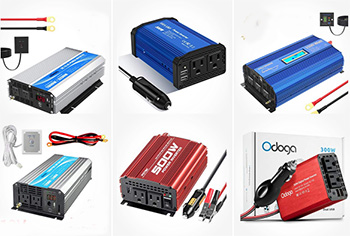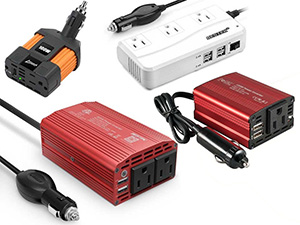You might be wondering how to choose a power inverter when you can’t get a hold of all those calculations, right? Don’t worry because we have translated those into English for you.
We won’t ask you to do massive calculations, and the toughest part of this article is at the end with some works of addition. After knowing the most important features of a power inverter, we will guide you through buying the best power inverter for home or your vehicle.
Why Do I Need A Power Inverter?
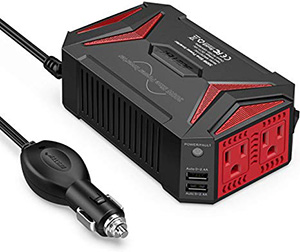
During such a situation, you will need your phone to have enough juice to call for help. But when danger comes, it comes from all directions. That is why having an emergency power backup system is very important.
Note: You can know more advantages of an inverter generator by reading our article and see if it is more suitable for you.
Different Types Of Inverters
Power inverters come in different types, features, and size. Based on different parameters, you can divide power inverters into 5 or 6 categories. But the most popular and most important type is categorized based on the output waveform. So, let’s talk about that in detail.
- The first one is called Pure Sine Wave power inverter, and it costs more. But that is reasonable because generating pure sine wave in an inverter is costly. The benefit is that pure sine wave inverters are the best for electronic devices, and this type of inverter runs medical equipment.
- The second one is called Modified Sine Wave or Quasi Sine Wave power inverter. These are more economical inverters that will give you imperfect sine waves. So, sensitive appliances like microwaves, laser printers, etc. can get damaged by it. But you can run almost all the other home appliances with it.
- The last one is called Square Wave power inverter, which has the lowest price and performs basic tasks. You can run motors and simple appliances like those with square waves.
How To Choose A Power Inverter?
Choosing the best inverter will require your focus on two major sections. The first one is determining the inverter size according to your needs. And the second one is ensuring all the necessary features in it. Without any more delay, let’s know how easily you can choose a power inverter.
Budget:
Fixing the budget is the first thing to do. Because no matter how good an inverter is, it must be affordable. So, according to your budget, you should look for the inverters that can generate pure sine waves on the output as it is best for your devices.
But you can choose modified sine wave inverters in case of a lower budget. Modified sine waves are also acceptable, but you shouldn’t run sensitive electronic appliances with it. For example, microwaves, laser printers, etc. can’t perform well with this wave.
Wattage:
After that, you must know the value or size of the power inverter. Depending on the value, you will know how many appliances you will be able to run at the same time. For more information and a better understanding, please scroll down a bit.
Number of outlets:
By fixing the number of appliances to be run at once, you will instantly know how many outlets will be enough for you. Also, make sure that the inverter you choose comes with USB ports and fast-charging capabilities.
Display:
Then, the display comes into consideration. Some inverters have a big display and show a lot of information like input voltage, output voltage, battery level, warning, and more. With lower budget inverters, the display size and features get decreased.
Safety:
Finally, make sure the safety features of the inverter. Check the specs and see if there are enough fuses on both the output and input. With fuses at every point, you will be assured that your battery, the appliances, and the inverter itself will be protected from surges or short-circuit problems.
How To Determine Inverter Size?
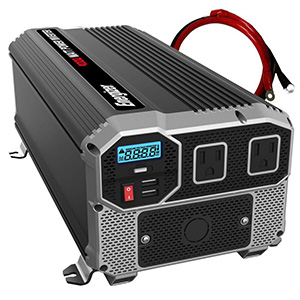
On the other hand, continuous power providing means you get an uninterrupted power supply until your battery dies. A 2000-watt battery means it will continuously generate 2000 watts and can give you approximately 3000 watts of surge power.
Now, you should calculate the total power consumption of the devices that you need to run simultaneously. Then, check the specs of your chosen power inverter and look if it has enough capacity to meet your requirements.
That is how you can determine inverter size, and you will know the approximate size that you might need below. The following information is merely a suggestion, and it will help you do the calculation correctly.
What Size Power Inverter Do I Need?
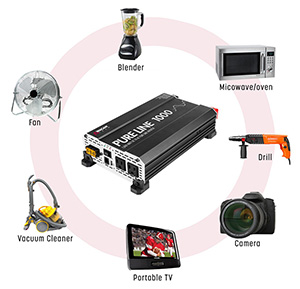
How did he do that? John checked the specs of the products and saw that his phone’s fast-charger needs 18 watts, each bulb needs 30 watts, and so on. Summing up the values, it became around 1500 watts.
To be safe and avoid over-voltage on the output, John should buy a power inverter with more capacity. Thus, he could realize the importance of getting a 2000-watt inverter. But what would happen if he needs an inverter with 4000-watt surge power?
In that case, he will have to choose a more powerful model. If you see our reviews on power inverters, you will see that there are 3000-watt affordable power inverters with approximately 4000-watt peak power. These are the best power inverter for trucks and enough to start its engine. That is how you set your requirements and buy accordingly.
Note: If you are confused between the inverter or generator, which is best for home use, you should read our article on that topic.
Frequently Asked Questions
Are power inverters safe?
Can a power inverter run a tv?
Can a power inverter run a refrigerator?
Can you charge a battery while using an inverter?
Final Remarks
Power inverters are a great help on rainy days. No matter what the situation or place, if you have a battery and a power inverter, you will have nothing to worry about. It will not give you power for a very long time but enough to call for help. So, read our tested reviews on the most efficient power inverters and order one today.

